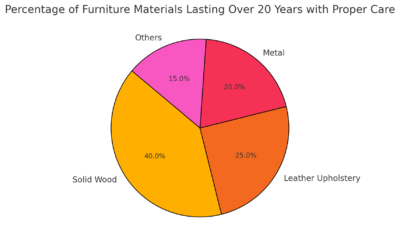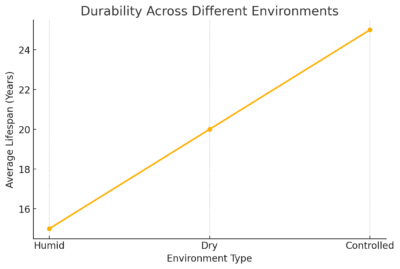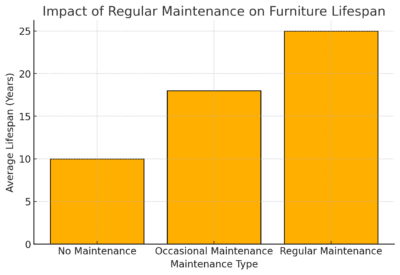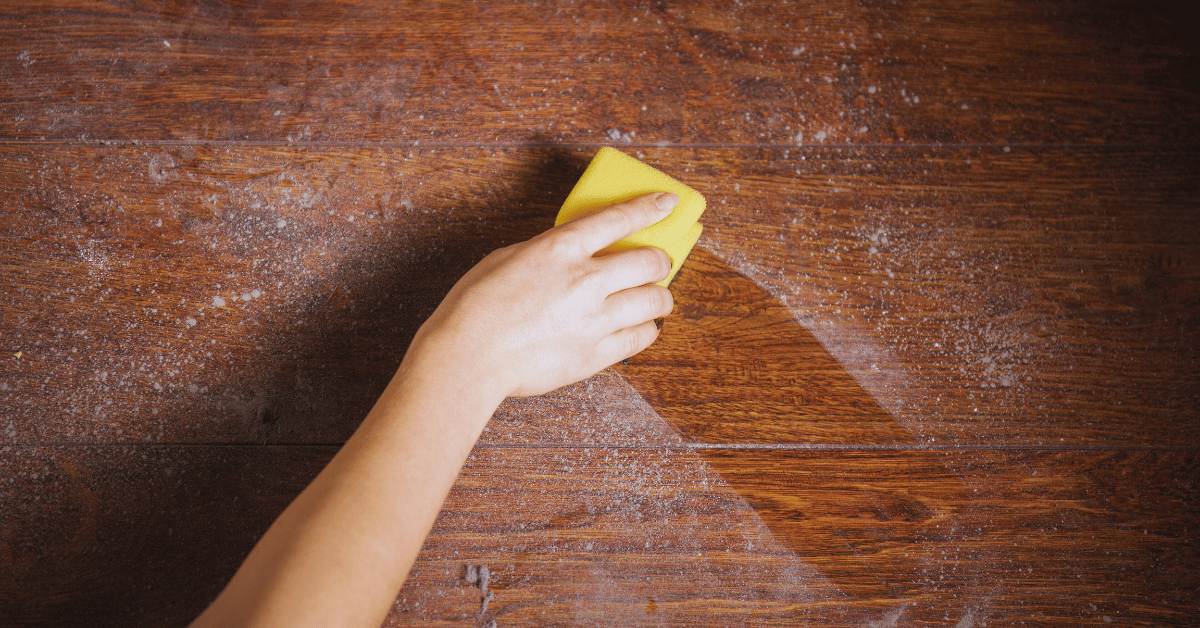Furniture durability is critical to maximizing the value and functionality of any space. This article explores the five key factors that significantly impact furniture lifespan: material quality, proper Usage, environmental conditions, regular maintenance, and protective measures. Homeowners and business owners can make informed decisions and maintain their furniture for decades by understanding these elements. Additionally, insights into the durability of various materials and actionable tips on care and protection are provided to help readers extend the life of their investments.
Introduction: Why Furniture Durability Matters
Furniture is essential to any residential, commercial, or industrial space. High-quality furniture enhances aesthetics, comfort, and functionality. However, like any investment, the longevity of furniture depends significantly on how well it is maintained and the factors influencing its durability. This guide explores five crucial factors that can extend the life of your furniture, ensuring it remains sturdy, beautiful, and functional for years.
For those looking for Modern Office Furniture in Dubai, quality and durability should be at the forefront of your decisions. Companies like Furnicraft.ae provide premium furniture solutions designed to last.
1. Material Quality
The type and quality of materials used to make furniture significantly affect its durability. Opting for superior materials ensures your furniture withstands wear and tear over time. Here’s a closer look:
a. Wood
- Solid Wood: Furniture made of solid Wood, such as oak, maple, or mahogany, lasts longer due to its strength.
- Engineered Wood: While MDF and plywood are less durable than solid Wood, high-quality variants can be a cost-effective and sturdy alternative.
b. Metal
- Stainless Steel: Resists corrosion and is ideal for furniture in humid environments.
- Aluminum: Lightweight yet durable, commonly used for outdoor furniture.
c. Upholstery Materials
- Leather: Genuine leather is elegant and highly durable with proper care.
- Fabric: High-quality, stain-resistant fabrics can endure frequent use and cleaning.
Key Takeaway: Investing in premium materials may come at a higher initial cost, but it ensures long-term savings as the furniture lasts longer. For those seeking Office Furniture in Dubai, consider durable options available at Furnicraft.ae.
2. Proper Usage and Weight Limits
Using furniture within its intended purpose and adhering to weight capacity limits can significantly prolong its lifespan. Misuse or Overloading can weaken joints, break frames, or damage upholstery.
a. Avoid Overloading
- Chairs and sofas have specified weight limits. Ensure these are not exceeded to prevent structural damage.
b. Suitable Usage
- Indoor vs Outdoor Furniture: Indoor furniture should not be exposed to harsh weather conditions as it’s not designed for such use.
- Multipurpose Furniture: Avoid overburdening multipurpose items like sofa beds or extendable tables.
c. Child and Pet Considerations
Children and pets can cause accidental damage. Using protective covers or training pets to avoid furniture can help mitigate this risk.
Key Takeaway: Follow manufacturer guidelines on Usage to ensure your furniture’s longevity. When purchasing Modern Office Furniture in Dubai, confirm the weight limits and intended Usage for better durability.
3. Environmental Conditions
The environment where your furniture is placed can affect its lifespan. Extreme temperatures, humidity, and exposure to sunlight can quickly deteriorate materials.
a. Protection from Humidity
- Wood: Excess humidity can cause Wood to warp, swell, or rot. Use a dehumidifier in high-humidity areas.
- Metal: Prevent rusting by avoiding prolonged exposure to moisture and applying protective coatings.
b. Temperature Control
- Extreme heat or cold can crack or warp materials like Wood and fabric. Keep furniture away from direct heat sources or air conditioning vents.
c. UV Protection
- Prolonged sunlight exposure can fade fabrics and weaken wood finishes. Use UV-blocking curtains or reposition furniture periodically.
Key Takeaway: Create a stable and controlled environment to prevent damage caused by temperature fluctuations and humidity. For resilient options, check out Office Furniture in Dubai.
4. Regular Maintenance and Cleaning
Proper care is essential for furniture durability. Cleaning and maintenance routines vary depending on the material and Usage.
a. Cleaning Practices
- Wood: Use mild cleaners and avoid excessive water. Dust regularly to prevent the buildup of grime.
- Fabric: Vacuum upholstered furniture weekly and clean stains immediately using fabric-safe cleaners.
- Metal: Wipe with a damp cloth and apply anti-rust sprays as needed.
b. Preventive Maintenance
- Tighten screws, bolts, and joints periodically to maintain structural integrity.
- Polish wooden surfaces with high-quality products to preserve their finish.
c. Deep Cleaning
- Professional cleaning for upholstery and leather items at least once a year can extend their life.
Key Takeaway: Consistent care and preventive maintenance are crucial for pristine furniture. Explore maintenance-friendly designs available at Furnicraft.ae.
5. Protective Measures
Taking proactive steps to protect your furniture can shield it from damage and wear.
a. Use Protective Pads
- Felt pads under the chair and table legs prevent scratches on flooring and reduce wear on furniture legs.
b. Covers and Throw Blankets
- Use covers to protect sofas and chairs from spills, stains, and pet damage.
c. Protective Coatings
- Sealants or coatings should be applied to preserve Wood and Metal from moisture and rust.
d. Rotating Usage
- Frequently used furniture should be rotated occasionally to distribute wear evenly, especially for items like cushions.
Key Takeaway: Small protective actions can significantly extend the lifespan of your furniture. Check out durable and protective designs at Furnicraft.ae.
6. Choosing the Right Furniture for Your Needs
When purchasing furniture, selecting items that suit your needs is critical for durability. Here’s how:
- Assess Usage: Determine how often and by whom the furniture will be used. For example, office chairs in high-traffic areas should be more robust than occasional seating in guest rooms.
- Style vs Functionality: Balance aesthetic appeal with practical use. Opt for modern designs without compromising strength and durability.
Key Takeaway: Prioritize functionality and match furniture choices to the specific demands of the environment.
7. Repair and Refurbishment Options
Extending furniture life can sometimes be as simple as repairing or refurbishing old pieces.
- Minor Repairs: Fix loose screws, apply touch-up paint, or replace broken parts immediately.
- Refurbishment: Sanding, polishing, or reupholstering can make old furniture look new.
- Professional Services: Engage professionals for extensive repairs, especially for high-value items like antique furniture.
Key Takeaway: Timely repairs and refurbishment can restore functionality and aesthetics, delaying the need for replacement.
8. Seasonal Care for Furniture
Different seasons can impact your furniture differently, requiring tailored care strategies:
- Winter: Use humidifiers to prevent the wood from drying and cracking.
- Summer: Avoid direct sunlight to prevent fading and discoloration.
- Rainy Season: Keep furniture dry and use anti-moisture sprays to protect against mold and mildew.
Key Takeaway: Adjust your maintenance routine according to seasonal challenges to protect your furniture.
9. Importance of Ergonomic Design in Modern Furniture
Ergonomics is not only about comfort but also about maintaining the structural integrity of furniture. Ergonomic furniture reduces undue stress on parts like joints and upholstery.
- Office Furniture: Adjustable chairs, desks, and workstations designed to support posture.
- Home Furniture: Ergonomically designed sofas and beds prevent excessive wear on cushions and frames.
Key Takeaway: Ergonomic furniture is a win-win, enhancing user comfort while ensuring the furniture lasts longer.
10. Sustainable Practices for Longevity
Sustainability goes hand in hand with durability. Here’s how to make eco-friendly and durable choices:
- Sustainable Materials: Bamboo, recycled metal, and FSC-certified wood.
- Eco-friendly Coatings: Use low-VOC varnishes and paints for added protection.
- Upcycling: Transform old furniture into new, functional pieces to reduce waste.
Key Takeaway: Sustainable practices not only help the environment but also extend the functional life of furniture.
11. Investing in Warranty and After-Sales Support
Warranty coverage can play a significant role in the longevity of your furniture:
- Warranty Benefits: Covers repairs and replacements for manufacturing defects.
- After-Sales Services: Many brands offer maintenance packages or professional cleaning services.
Key Takeaway: Choose reputable brands that provide warranties and after-sales services for long-term peace of mind.
12. Trends in Durable Furniture
Understanding the latest trends can help you make informed decisions about durable furniture:
- Smart Furniture: Furniture integrated with technology, like adjustable smart desks, designed to last.
- Modular Furniture: Pieces that can be reconfigured or expanded to suit different needs.
- Minimalist Designs: Less clutter means fewer points of wear and tear.
Key Takeaway: Keeping up with trends ensures your furniture remains relevant, functional, and long-lasting.
13. Common Mistakes to Avoid
Avoid these mistakes that can reduce furniture lifespan:
- Neglecting Maintenance: Skipping regular cleaning or repairs.
- Improper Assembly: Ensure all parts are securely fixed during assembly to prevent future issues.
- Ignoring Manufacturer Instructions: Always follow the manufacturer’s care and usage guidelines.
Key Takeaway: Avoiding these common pitfalls can significantly enhance your furniture’s durability.
14. Planning Furniture Layout for Durability
The way furniture is placed in a room impacts its longevity:
- Avoid High-Traffic Areas: Place delicate furniture like glass-top tables away from frequently used pathways.
- Even Weight Distribution: Use furniture pads to balance weight on uneven floors.
- Proper Spacing: Ensure adequate space between items to prevent collisions and scratches.
Key Takeaway: Thoughtful placement reduces the risk of accidental damage.
Overview of Furniture Longevity
| Material | Average Lifespan (Years) | With Proper Care (Years) |
|---|---|---|
| Solid Wood | 15–20 | 25+ |
| Engineered Wood | 5–10 | 12–15 |
| Upholstered Fabric | 5–8 | 10+ |
| Leather Upholstery | 10–15 | 20+ |
| Metal (Steel/Aluminum) | 10–20 | 25+ |
Percentage of Furniture Materials Lasting Over 20 Years with Proper Care

Durability Across Different Environments

Impact of Regular Maintenance on Furniture Lifespan

Key Takeaways
- Invest in high-quality materials for lasting furniture.
- Adhere to proper usage guidelines to avoid structural damage.
- Maintain a controlled environment to prevent environmental degradation.
- Commit to regular cleaning and maintenance to preserve furniture.
- Utilize protective measures to safeguard against wear and tear.
Related Posts
- Importance of Features in Workstation Power Socket in Dubai for Modern Offices
- Popular Options for Connectivity Box for Desks in Dubai Offices
- Essential Desktop Power Distribution Sockets for a Productive Dubai Office
- Most Popular Features of Connectivity Boxes for Conference Tables
- Dubai’s Top Office Furniture Stores: Your Ultimate Buying Guide
Conclusion
Extending the lifespan of your furniture is not just about maintenance; it involves choosing suitable materials, using the furniture as intended, and protecting it from environmental factors. Adopting these five strategies ensures that your furniture remains functional, stylish, and durable for many years.
For top-quality Modern Office Furniture in Dubai and maintenance-friendly designs, visit Furnicraft.ae today!
FAQs: 5 Factors to Prolong Furniture Durability
1. What is the most durable material for furniture?
Solid wood (like oak, mahogany, and teak), stainless steel, and genuine leather are the most durable materials for furniture. These materials are highly resistant to wear and tear and can last decades with proper care.
2. How often should furniture be cleaned and maintained?
For most furniture, cleaning should be done weekly to remove dust and debris. Deep cleaning for upholstery and leather should be performed annually, while maintenance tasks like tightening screws or applying polish should be done every 6 months.
3. How can I protect my furniture from humidity and moisture?
To protect furniture from humidity:
- Use a dehumidifier in humid climates.
- Apply water-resistant coatings to wood and metal furniture.
- Avoid placing furniture in damp areas or near water sources.
4. Does sunlight affect the durability of furniture?
Yes, prolonged sunlight exposure can fade fabrics, discolor wood finishes, and weaken materials. To limit direct sunlight exposure, use UV-blocking curtains, furniture covers, or reposition furniture.
5. What are the best practices for maintaining upholstered furniture?
To maintain upholstered furniture:
- Vacuum regularly to remove dust and allergens.
- Treat spills and stains immediately using fabric-safe cleaners.
- Rotate cushions periodically to ensure even wear.
If you are searching for
- Office Furniture Stores in Dubai
- Modern Office Furniture in Dubai
- Office Furniture Store Dubai
- Office Furniture in Dubai
- Office Furniture Company in Dubai
- Luxury Office Furniture Dubai
- Office Furniture Suppliers in Dubai
- Best Office Furniture in Dubai
Contact us today to learn more about our premium office furniture in Dubai!

